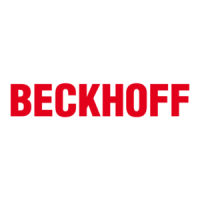Basic Function Principles
BK52x0 and LC5200 17Version: 2.0.0
Analog outputs receive 16bits of data, i.e. two bytes, per channel. An analog output terminal with 2channels
must therefore receive 4bytes. A digital output terminal with 2channels requires a total of 2bits of data, 1bit
for each channel.
First the data from all the analog outputs
The first 4bytes of an object transmitted to the terminal strip are assigned to the first analog output terminal,
which is the analog output terminal closest to the Bus Coupler. Other terminals which are located between
the Bus Coupler and the first analog output terminals are disregarded. The next four bytes of the object go to
the second analog output terminal in the terminal strip. Any other terminals between the first and second
analog output terminals are disregarded.
Then the data for the digital outputs is transmitted in bytes
When the last analog output terminal in the terminal strip has received its data, the digital outputs are served.
Data is always transmitted byte-by-byte. The next byte from the data string contains the data for 8 digital
outputs. Bit0 and bit1 are assigned to channels 1 and 2 of the first digital output terminal after the Bus
Coupler. Other types of terminals which are located in between are ignored.
Bit2 and bit3 go to the 2 channels of the second digital output terminal, bit4 and bit5 to the third and bit6
and bit7 to the fourth. There may be other terminals located between these digital output terminals, and if so
they will be disregarded.
Additional bytes are read from the data string until the last digital output in the terminal strip has been dealt
with. If the total number of digital outputs is not a multiple of 8, there will be a number of bits left over in the
last data byte; these will be discarded.
Fig.7: Data exchange
Object from the Bus Coupler to the DeviceNet master for transferring the input data
The object sent by the Bus Coupler to the DeviceNet master also contains the byte-oriented data at the
beginning, followed by the bit-oriented data. Transfers in this direction also include a status byte, which
comes right at the end of the object.
The byte-oriented data contains the values from the analog inputs and the bit-oriented data the values from
the digital inputs.
Byte-by-byte data
The first four bytes contain the data of the first analog input terminal in the terminal strip. 2bytes form the 16-
bit value of each input. The next fourbytes correspond to the next analog input terminal and so on,
analogously to the procedure described above.
Bit-by-bit data
After the byte-oriented data from all the analog inputs come the values from the digital inputs. Eightdigital
inputs are transferred in each byte. As before, if the total number of digital inputs in the terminal strip is not a
multiple of 8, the last data byte will contain one or more unused bits.

